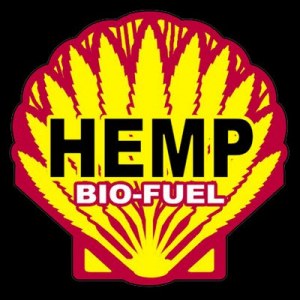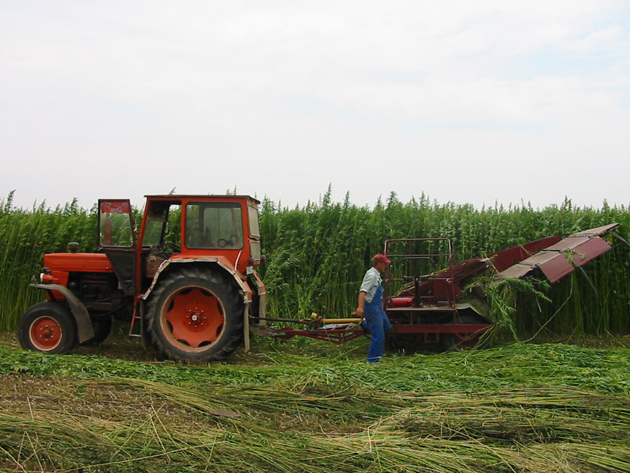|
Ford recognized the utility of the hemp plant. He constructed a car of resin stiffened hemp fiber, and even ran the car on ethanol made from hemp. Ford knew that hemp could produce vast economic resources if widely cultivated. - HempCar

hempnews.tv
Bio fuels fall into 2 categories. 1) BioDiesel (oil-based fuel for diesel engines) and 2) Ethenol (an alcohol for petrol engines). If you have a regular petrol engine, you can run 15% ethanol (E-15) right now, with no conversion. If you want to use 85% ethanol (E-85), you would need to have your engine converted or own a car that is a Flexible Fuel Vehicle (FFV).If you have a diesel (compression-ignition) engine, you can run biodiesel right now. Power stations can also be produced locally.
Both ethanol and biodiesel are made from renewable sources with the goal in mind to be more environmentally sound and to decrease the dependence on foreign oil.Despite the fuel source coming from bio mass, the choice of the bio mass and the means of the production of it will determine the environmental benefits.
These environmental factors include the preservation of the environment, emissions and fossil fuel usage involved in the means of production.
A new government study shows that the Department of Transport's aim to increase the level of biofuel in fuel sold across Britain will result in millions of acres of forest being burned down and turned into plantations. The findings of the study showed that using palm oil instead of fossil fuel increase emissions by 31 per cent, failing to meet the European Commission standard of each litre of biofuel reducing emissions by 35 per cent.-Source
Ethanol can come from many sources, the primary substance that comprises it is a grain, usually corn, sometimes wheat, or barley,in the US right now, it's mostly corn. Brazil has been using alcohol because their primary fermentation source is sugar cane, which thrives in their environment and produces sucrose, which, as a disaccharide, can be fermented natively by the yeast, without the need for amylase mashing. Unfortunately, vegetation rich in mono- and disaccharides do not grow well except in the extreme southern portion of the US--and those that do are used for sugar production, meaning that, for operations that do not require extensive imports from other countries, starch or cellulose driven mashes must be used. Cellulose-based mashes are not yet cost effective, as cellulase is still prohibitively expensive for use in mass production.
None of these means of production compare with the environmental and economic benefits of using hemp as the source.
The added cost of the extra drying needed for crops such as sugar cane, corn and Napier grasses make these high moisture plants an inefficient source for growing methanol. Hemp turns out to be the most cost-efficient and valuable of all the fuel crops. Hemp ethanol will only cost 50 cents per gallon. Planting only 6 percent of the continental United States with biomass crops such as hemp would supply all current domestic demands for oil and gas. Yet no there is legislation,carbon tax scheme, encouragement and endorsement from government bodies to educte and encourages this. WHY? We have a political and and educational crisis.
The Economics, History and Politics of Hemp Fuels is alarming to say the very least.

Harvest Picture courtesy of Ecolution® in Romania -Source
The advantages that any biofuels will deliver will be that they provide more BTU than it takes to plant, maintain harvest and process (Ethanol makes 90k BTU per gallon, and gasoline is about 120k.).The USDA and University of Nebraska studied biomass from cellulose feed stock and what they found should be encouraging. A cellulose feedstock (like industrial hemp) can produce 540% more energy than it consumes in it's production.
When considering industrial hemp as the feed stock there are several advantages this weed provides over other feed stocks for biofuels. Hemp can be harvestede two to three times a season.It can be grown on marginal lands,along the edges in areas where either nothing is currently growing or useless weeds thrive anyway. High yeild plants with thousands of uses besides energy this can create jobs in industries that have been outsourced. A few by products can help spread the risk out and diversify the portfolio of comodities. When hemp is compared to corn for biofuels hemp wins hands down. Corn ethanol is inefficient as a fuel crop it produces only 25% more energy than it consumes to produce the ethanol fuels.
Facts celary show that Industrial hemp is the number one biomass producer on earth, meaning an actual contender for an economically competitive, clean burning fuel. Hemp has four times the biomass and cellulose potential and eight times the methanol potential of its closest competing crop - corn. Burning coal and oil are the greatest sources of acid rain; biomass fuels burn clean and contain no sulphur and produce no ash during combustion.
The cycle of growing and burning biomass crops keeps the world’s carbon dioxide level at perfect equilibrium, which means that we are less likely to experience the global climactic changes (greenhouse effect) brought about by excess carbon dioxide and water vapors after burning fossil fuels. Think of all the economic opportunities that could be created by producing clean energy instead of endangering our health and safety with the last remains of an unsustainable and dirty source.
HEMP production for Bio fuels or any products is also a superior carbon reduction method regardless of climate science, the health benefits speak for themselves. As far as Carbon credits goes HEMP is also a superior tradable permit scheme
Biomass from food crops and their byproducts is used to make Biofuel. Bast fibre crops include such species as Flax, Kenaf, Sun Hemp and Industrial Hemp. The “hurd” is the inner woody core of the bast fibre plant’s stem. In general bast fibre crops produce the greatest amount of usable bio-mass, over the shortest period, for the least amount of water.Bast crops are a highly efficient mop crop and can use most types of waste or even brackish water.
Between 1.7 and 1.9 tonnes of carbon dioxide is absorbed from the atmosphere for each tonne of bast crop cellulose produced. Typically one can grow 10-14 tonnes of crop straw per hectare. Another 2-3 tonnes of cellulose mass is produced and stored in the root system. So each hectare of hemp could immediately sequester some 22 tonnes of greenhouse gases. Bast crops are able to sequester more carbon than trees in a short 150 day season cycle and yet leave arable land available for food and other crop production in the remainder of the year.-Hemp Carbon credits.

Harvest Picture courtesy of Ecolution® in Romania -Source
The health issues are far more reaching.
American, Australian and new Zealand residents living near coal-fired power stations are exposed to higher radiation does then those living near power plants that meet government regulations.-Source
The following is information extracted from a study done by Dr Mark Diesendorf, who teaches sustainable development at the Institute of Environmental Studies at the University of New South Wales.
Quote-Mark Diesendorf: Australia has the biggest per capita emissions of greenhouse gases in the world. Australia’s biggest single source of emissions is burning coal to generate electricity. Coal-burning also emits dangerous air pollutants, including oxides of sulphur and nitrogen, sulphuric and hydrochloric acid, boron, fluoride, particulate matter, mercury and even low-level radioactivity. In addition, coal is responsible for much water pollution, water consumption, land degradation, and occupational health and safety hazards.
It is claimed by some that existing renewable energy sources, such as wind, solar or biomass, are not capable of substituting for coal-fired power stations. Well this notion has been refuted by a set of scenario studies for a clean energy future for Australia and its States. The results of these studies indicate that combinations of efficient energy use, renewable energy, and as a transitional fuel, natural gas, are technologically feasible now. Furthermore, the clean energy mix may also be cheaper than continuing with coal, even without taking into account the huge environmental and health costs of coal.
A very important benefit of undertaking the transition to a clean energy future is that it will stimulate job growth and increased economic activity. For each unit of electricity generated, wind power creates two to three times the number of local jobs as coal, while bio-electricity generates 3.5 times, and most of its jobs are in rural areas where they’re needed. Mark Diesendorf Institute of Environmental Studies at the University of New South Wales -End quote
That was 3.5 times the jobs created by the alternative inferstructure then a coal power station station.
Despite these facts political circles fail to implement HEMP and are so far still attempting to endorse Nulcear power in Australia.
Coastal sites for nuclear reactors named
SEVENTEEN nuclear reactors are likely to be spaced out along the Australian coast from Townsville in Queensland to Port Augusta in South Australia under a nuclear-powered future, a new study has revealed. Left-wing think tank the Australia Institute said Queensland could have six reactors located in Townsville, Mackay, Rockhampton, Bundaberg, Sunshine Coast and Bribie Island.
Port Stephens, the Central Coast, Port Kembla and Jervis Bay/Sussex Inlet were named as NSW/ACT locations. In Victoria, South Gippsland, Westernport, Port Phillip and Portland were named as reactor sites, while in South Australia, Mt Gambier/Millicent, Port Adelaide and Port Augusta/Port Pirie were identified. The reactor sites were chosen based on criteria such as proximity to seawater for cooling and access to the national electricity grid.
The institute also surveyed 1200 Australians on their attitude towards having a reactor in their local area and found that 66 per cent were opposed. A quarter of those surveyed, 25 per cent, were supportive and nine per cent undecided. Fifty-five per cent were strongly opposed and just 10 per cent strongly in favour.
Greens senator Kerry Nettle said the report unsurprisingly showed that populations close to the suggested sites did not want nuclear power plants. "Instead of talking about 25 possible nuclear power plants, the prime minister should be looking for another 25 sites for major wind power stations and another 25 solar power stations," she said. Source
Some politicans also change their mind.
As of June 10, 2008-Federal Environment Minister Peter Garrett says the government will fulfil a Howard-government era policy to build a nuclear waste dump.The proposal, believed to include several locations in the Northern Territory, was opposed by Mr Garrett before the election.-Source.
By evaluation of these facts, it should now be clear from any view point why there is no justification for the government to choose to ignore the avenues which Bio fuels and geo thermal stations can benefit.Is there a deeper conspiracy involving nuclear and oil companies?
We the public need to concern our self’s with the clear justified solution here for our health. Public pressure for these programs to be grant implemented and adopoted by governments is required.
Panacea intends on creating a Bio fuel Hemp station in Australia. If you are an organisation which can aid in the growth, and manufacture of hemp towards this task please contact Panacea.
PLEASE SIGN THE PETITION FOR CLEAN HEMP BIO FUEL ENEGRY! SIGN THE PETITIONS HERE!
Panacea is a not for profit organisation and needs support. Any aid agency who can help, or any member of the public please contact Panacea.
Research links
Video - Biodiesel from Hemp
Video -On Biomass (and Hemp)
HempPharm.com
hempworld.com/Hemp-CyberFarm
http://hemp-ethanol.blogspot.com
Further Research on hemp
|